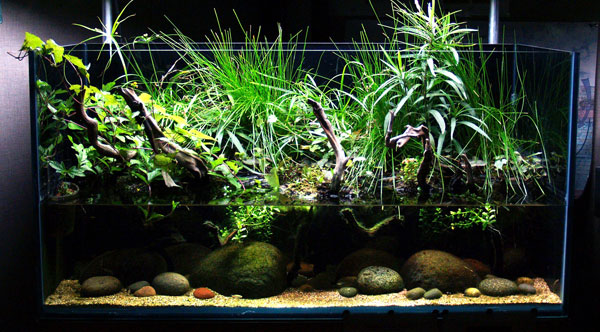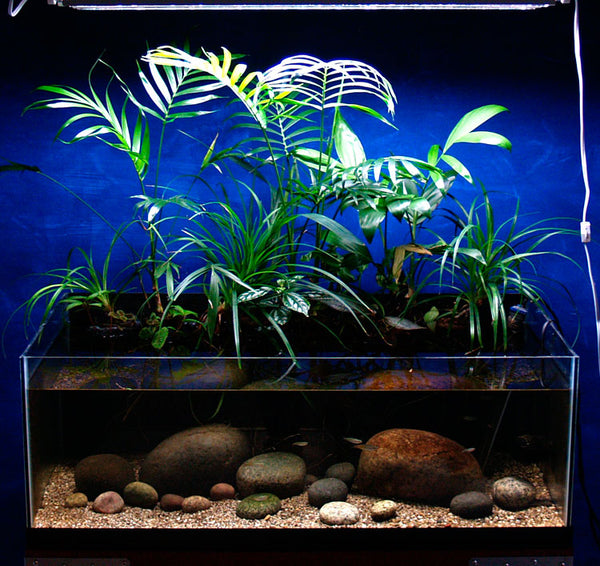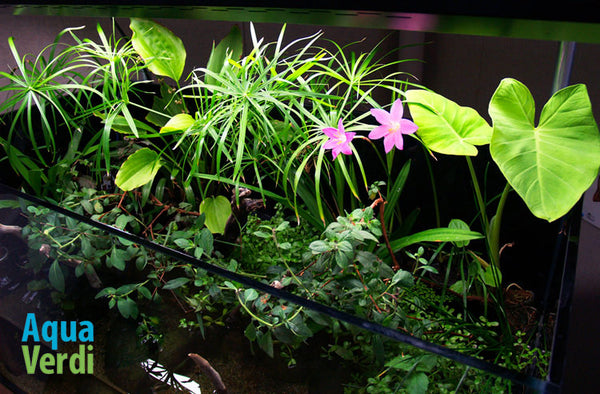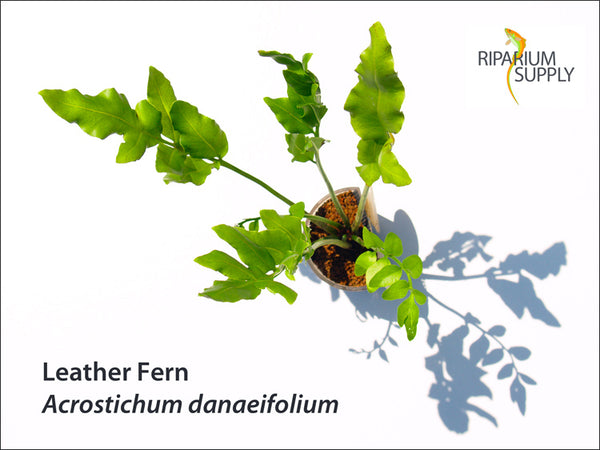News / Aquascaping
Swamp Tank: Happy Plants in the Riparium Setup at Fish Planet in Deerfield, Illinois
Steve at Fish Planet sent us a few update shots for his showroom riparium planting. The plants look very good and the tank has been a big hit with customers. The following lists basic specifications for this planted model ecosystem:
- Tank - 45-gallon cube (24" X 24") - a great size and shape for a riparium planting
- Lighting - 4X 24", 6,500K HO T5 lamps in pendant fixture, lighting for underwater area supplemented with Finnex I LED strip
- Water circulation/filtration - Eheim 2213 canister supplemented with 100 gph power filter
The robust plant growth above and below water provides lots of natural water purification and habitat structure, allowing for an active fish display with lots of animals. Livestock include Neon Dwarf Rainbows, Silver Hatchetfish, Pygmy Cories and Burmese Rasboras. Among the submerged aquatic plants are various Crypts, Java Fern and Christmas Moss. Riparium plants include Colocasia Dwarf Taro, Ruellia Dwarf Bluebell, Ruellia Tall Bluebell and Acorus Japanese Sweetflag. Notice also the floating leaves of Nymphaea Dwarf Lily.

There is no CO2 injection to enhance underwater plant growth; the tank uses instead a natural approach with the generous fish stocking and bioactive substrates. The riparium plants of course acquire all of the carbon dioxide they need directly from the air, where it is usually much more available than underwater. The submerged plants and riparium plants do benefit with twice-weekly fert dosing for NPK and micronutrients.
We look forward to more updates on this beautiful riparium. It looks as the the Ruellia plant might flower soon with its lovely pink blossoms. That will be a treat!
Neon Dwarf Rainbowfish (Melanotaenia praecox) - an excellent choice for an active fish display in a planted tank.

Colocasia Dwarf Taro with other riparium foliage

The Ruellia Tall Bluebell has numerous flower buds and will bloom soon.

Build a Planted Riparium!
Visit the Aqua Verdi/Riparium Supply site, subscribe to our YouTube channel and watch our Facebook page for tips, new products and design ideas you can use to build a beautiful, relatively easy-care ecosystem display.
The attached photograph shows a Central America/Mexico biotope riparium in a 50-gallon tank. Plants include Acorus Japanese Sweetflag, Acrostichum Leather Fern and Ruellia Dwarf Bluebell.
Use this coupon code in the Aqua Verdi store for a 15% discount on riparium planters and other items in our Dry Goods Collection...
AQUA15

Video: Planting the Limpet Moss Mount
Our newest video details planting of the Limpet Moss Mount with some new tissue culture plants. Follow this link to watch on YouTube...
Video: Planting the Limpet Moss Mount
The Limpet is a laser-cut acrylic plate supplied with a heavy-duty suction cup and it works well with plants that grow on hard substrates, such as Aunties, smaller Java fern, Bucephalandra and aquarium mosses. In contrast with moss ledges of comparable design, the Limpet Moss Mount plate hangs vertically, so it can look more natural in the aquarium and it will cast less shade on other plants as the mosses grow in.

Use the Limpet Moss Mount to expand your aquarium growing area and propagate plants for trades or aquascapes. With moss or other plant grown to cover the mount, the Limpet can also function as a unique aquascape feature. It will additionally create new habitat for aquarium livestock and it might even function well as a spawning mop for killifish and other egg scattering fish.

The Limpet Moss Mount is packaged as a 2-pack. Make sure to review the instructions on the reverse side of the packaging as you get ready to plant. As with our other glass-mount accessories, the heavy-duty suction cups will provide a strong grip for a long time if the aquarium glass is carefully cleaned with a razor blade or similar scraper before positioning.
Have fun with with your aquarium plantings!
Part 1: Three Riparium Biotope Ideas
This short series of posts will offer suggestions for planning and establishing biotope ripariums to represent the aquatic habitats of three different regions. Aquarium biotopes create the most natural-looking combinations of plants, substrates and livestock, while also providing excellent opportunities to learn about the flora, fauna and ecology of beautiful wild places. We should all build more of them!
Part 1: Southern United States, Mexico & Central America

The Biotope: the freshwater aquatic habitats in this vast area are represented by a wide variety of distinctive ecosystems that include swamps, rivers, lakes and mountain streams, but there is a certain amount of overlap in the aquatic plant and fish diversity. While planning a riparium biotope for specific kinds of fish, the aquarist should focus on a specific area and habitat to guide plant, hardscape and substrate choices.
Hardscape & Substrate: try to find photos or scientific descriptions for the specific area you wish to represent. There is wide variety. Mountain streams in the Southern United States, Mexico and Central America are typically lined with large rounded boulders and finer gravel particles. Swamps, marshes and quiet creeks can be recreated in the aquarium with gentle water flow and finer gravel substrate combined with sunken manzanita twigs and oak or magnolia leaves. Lakes often have more angular boulders and beds of sand or fine gravel. A large sunken driftwood stump can also help to recreate a lake environment.
Livestock: the most popular aquarium fish from this region are livebearers in Family Poecilidae and various cichlids (Family Cichlidae). Among fish from the Southeastern United States, an area with exceptionally high fish biodiversity, are a few other groups kept in aquariums, such as cyprinids and darters. Very small livebearers, such as Heterandria formosa, can be housed in nano tanks of just a few gallons, while large Central American cichlids or groups of Poecilia sailfin mollies might require aquariums of 75 gallons or larger. There are also many fish species options from this area to inhabit medium-size tanks, such as wild type Xiphophorus platies & swordtails and Cryptoheros cichlids. The Mexico-endemic livebearer family, Goodeidae, also includes fascinating and beautiful aquarium choices.
Riparium plants: fortunately, a number of the best, well-tested riparium plant choices originate from this area. The following lists several of these with notes:
- Asclepias curassavica "Mexican Milkweed" - this tropical relative of the familiar monarch butterfly food plant grows in wet, sunny places throughout the Southern United States, Mexico and Central America. It is one of the easiest riparium plants to grow and bloom. Combine it with grassy riparium plants, such as Cyperus, to create a riverbank or marsh environment.
- Cyperus spp. dwarf "Umbrella Sedge" - there are three or four different small-growing Cyperus species available for sale in the gardening trade. While they may not necessarily be from this area, there are dozens of native species of Cyperus from wet habitats in this area that share the characteristic tall stalk with a a whorl of grassy leaves on top, so the common garden varieties will work well as riparium stand-ins.
- Echinodorus cordifolius - another species that occurs throughout this area, this is also the Echinodorus swordplant that adapts best as an emersed plant in riparium conditions. The all-green species plant grows to a large size relatively fast, so it is a good choice for filling out a larger planting, while the white-variegated cultivar E. cordifolius 'Tropica Marble Queen', stays shorter.
- Ruellia brittoniana "Mexican Petunia" - another widespread plant in this area, R. brittoniana is available as several different cultivars that vary in stature and flower color. The dwarf forms of Ruellia brittoniana have foliage that reaches out across the water horizontally and are especially useful for adding visual depth and hiding riparium planters. Provided with good light and fertilization, Mexican petunias will flower abundantly in the riparium with white, blue, pink or violet blossoms.
- Spathiphyllum spp. "Peace Lily" - this familiar houseplant originates from the tropical species that grow along rainforest swamps and streams in Southern Mexico and Central America, as well as South America. Use it with the above species and others to create a biotope for poecilids and cichlids from these more tropical areas.
-
Zephyranthes spp. "Rain Lily" - this true lily grows from a bulb and blooms with beautiful white, yellow or pink flowers. It is very easy to grow, but the the flimsy, onion-like leaves provide little foliage, so it should be combined with other more robust plants in the riparium layout.
With some research, a dedicated hobbyists can find other possibilities among hardscape, livestock and riparium plants choices to recreate aquatic biotopes for this region. Some of the plants mentioned in the list above are actually represented by numerous different species in the Southern US, Mexico and Central America that might be difficult to find, but the species available as garden plants, including the Riparium Supply selections in our online store, can work well as stand-in representatives.
Thank you for reading! Stay tuned and watch for our next two articles to offer more ideas for planted riparium biotopes.



No extra CO2 Required!...And Other Reasons for a Planted Riparium as Your Next Aquascape.
We are quickly approaching the long, grey, cold winter months and the best time of year for new aquascaping projects. As you start planning your new layouts, consider trying a planted riparium.

Above, riparium layout in a 40-gallon tank.
Ripariums are a special kind of planted tank featuring marginal aquatic plants; species adapted to grow their roots in very wet soil or in the mud under shallow water, but with most of their foliage in the air. Some very popular aquarium selections, such as Cryptocoryne, Echinodorus, Anubias and many stem plants can grow as marginals with emersed-adapted foliage growing above water, although for aquariums these are usually grown in their immersed (underwater) forms.
Ripariums are further distinguished from another special kind of planted model ecosystem, the paludarium. While they look superficially similar, paludariums use a built-up hardscape to support the planting, whereas ripariums use planter cups positioned on the aquarium glass. Furthermore, the paludarium hardscape is intended to function as part of the visual design, while the riparium planters are hidden from view as the plants grow in.
The following lists the most appealing features of planted ripariums as living displays:
- No extra CO2 required - carbon dioxide gas, essential for plant growth, is many times more available in the air than underwater. Plants in traditional aquascapes are usually limited more be the availability of CO2 than any other factor, so serious aquascapers install CO2 injection systems with pressurized tanks, regulators and diffusers. While CO2 systems can be fun to set up and run, they also represent extra expense and maintenance demands. Riparium plants easily get all of the carbon dioxide they need from the air, so they do not need extra CO2 for vigorous growth.
- Biotope representation - some of the most beautiful wild aquatic ecosystems have few fully submerged underwater plants. Among these are blackwater swamps, mangrove swamps, mountain streams and others with underwater conditions that are tough for plants. These habitats are home to many of the most appealing aquarium fishes, while also hosting distinctive marginal aquatic plant species. A planted riparium is the best way to represent this kind of area with an aquascape biotope.
- Robust plant-based filtration - riparium plants, not limited by availability of dissolved CO2 or algae growth, can grow quickly with new foliage and roots. As they accumulate biomass, the riparium plants will also remove fish waste products (especially phosphate and nitrates) and other pollutants.
- Beautiful blooms and foliage - having evolved in the special marginal aquatic habitat, the best choices for planted ripariums have distinctive shapes, colors and growth habits. If provided with the right nutrition and lighting, a number of the best riparium selections, such as Ruellia, Spathiphyllum, Hymenocallis and Zephyranthes, will also bloom readily with lovely flowers. The planted riparium genre is relatively new in the aquarium hobby and there are still many new plants to be discovered and trialed as riparium choices.
Thank you for reading! We hope that you can also enjoy creative challenges and new discoveries with planning and building a new riparium aquascape.

Above, 120-gallon Mexico river riparium biotope.

Above, Planting Zephyranthes Rain Lily in Aqua Verdi Riparium Planter.

Above, the lovely white bloom of Zephyranthes Rain Lily in a planted riparium.

Above, a Borneo blackwater swamp riparium biotope.

Above, Acrostichum Leather Fern in a riparium planter.





